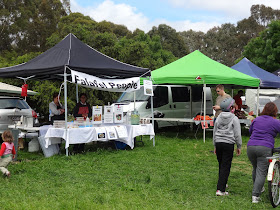When I was planning my round the world theme for the month I thought it would be a good idea to finish off with a recipe from Australia. It was tempting to make an Aussie classic like a vegan meat pie or lamingtons yet I've had a childhood recipe in mind to try for some time. Although jelly cakes may not be the most well known recipe, they were my mum's speciality when I was growing up and would always be present at parties and school fundraising fetes. Friends would pre-order them before she arrived at the cake stall and the remaining cakes would sell out very quickly. Jelly cakes are similar to lamingtons but the small patty cakes are dunked into a wobbly half-set jelly rather than chocolate icing prior to being rolled in coconut.
Patty cakes were common when I was growing up which are a much smaller version of a cupcake. We never had anything larger than patty cakes in those days and their miniature size meant that you could eat two or three in a sitting. I found a
jelly cake recipe on taste.com.au which used patty cakes and made a few vegan substitutions to the cake batter. This recipe called for self-raising flour which I was out of, although a quick search showed that plain flour, cream of tartar and bicarbonate of soda could be used in it's place.
A packet of vegan jelly crystals had been sitting in my pantry for months which I bought for the sole purpose of making this recipe. The trickiest part to making jelly cakes is getting the consistency of the jelly perfect for dunking. If it's too runny the jelly won't adhere to the cake, if it's too firm the cakes are likely to break up during the dunking. My cakes turned out a lighter colour than I expected and I'm not sure whether this was due to a slightly runny jelly or just a different product. The jelly that mum used to buy was probably full of artificial colourings as it was a lot darker than the vegan jelly.

I've heard many people rave about coconut whipped cream which I tried recently and thought it tasted overwhelmingly like coconut so I used cashews to make cream for the filling. After soaking and rinsing the cashews, they were blended with water, maple syrup and some vanilla essence. I prefer this type of cream as it has a more neutral taste and even though it's runnier, a quick spell in the refrigerator firms it up a little.
I was pleased with how the jelly cakes turned out and they have been popular with my fellows at home. Revisiting recipes from childhood is always an enjoyable experience, especially when the vegan recipes work out tasting just as good as the original.
Jelly Cakes (Adapted from
taste.com.au)
Makes 18 cakes
1 packet raspberry or strawberry vegan jelly crystals
60g dairy-free margarine
½ cup raw castor sugar
1 tablespoon ground flaxseed mixed with 3 tablespoons water
¼ teaspoon vanilla essence
1 cup plain flour (or use self-raising and skip the next 2 ingredients)
½ teaspoon cream of tartar
¼ teaspoon bicarbonate of soda
2/3 cup soy milk (or other non-dairy)
1 cup cashews (soaked in hot water for an hour)
½ cup water
1 tablespoon maple syrup (or to taste)
¼ teaspoon vanilla essence
1 cup desiccated coconut
Preheat oven to 180C.
Prepare jelly according to package directions and place in the refrigerator for 1 hour. The jelly should be set enough to be able to coat the cakes with jelly but not too firm otherwise the cakes will fall apart.
Cream the butter and sugar together using a hand held mixer. Add the flaxseed mixture and vanilla essence and beat until combined. Fold the flour, cream of tartar, bicarbonate of soda and soy milk through the mixture with a metal spoon.
Place patty pan cake wrappers in a muffin tray. Add a heaped tablespoon of cake batter to each of of the cake wrappers, they should be about half full. Bake for 20 minutes in the oven until an inserted skewer comes out clean and the cakes are golden on top. Remove the cakes from the tray and allow to cool on a wire rack.
Drain the soaked cashews and rise well with cold water. Place the cashews in a blender with 1/2 cup of water, maple syrup and vanilla essence and process until it becomes smooth and creamy. Transfer to a bowl and refrigerate for at least 30 minutes to allow it to thicken up a little.
Remove the cake wrappers from the cakes. Submerge each of the cakes into the jelly then drain off the excess jelly and roll them in coconut. Cut 3/4 of the way through the centre of the cakes and place a teaspoon or two of cashew cream inside.







.JPG)




.JPG)



.JPG)


















.JPG)

